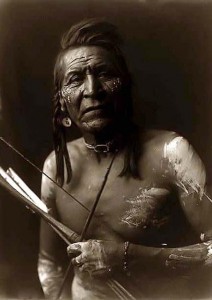In the “Time of Beginnings”, people and animals were a great deal alike and could speak with one another. Then, Kovati set out to give the living things their own characteristics. For example, he created Beaver (one of the First Beings) into the first beaver by placing a mussel shell knife on his backside and created Deer into the ancestor of all deers by placing pointed shell knives on the sides of his head for ears.
It’s interesting that the Quileutes illustrate this procedure of transformation, having descended as a people from wolves who were transformed by K’wa’iti into Quileutes at the Time of Beginnings. Indeed, the Quileutes seem unique in that the animals appear to have been made from people and the Quileutes changed from wolves into people. But, the old people sensed that all of the First Beings had characteristics of both people and animals. So, the Quileutes are merely the First Beings that wound up Quileute after transformation, and the other animals are First Beings that were transmuted into animals, birds, the great trees and other things with souls.
It’s known to the Quileute view that people are not higher or more exceptional than other living things. It established a topic of concern that the Quileutes, beings-with-souls, hunted and killed other beings-with-souls. And for that cause hunting was a pursuit that called for sensitivity and ritual.
 Hunting was a much more significant facet of Quileute cultural life and economic practices in aboriginal times. According to numerous statements in the ethnographical and historical record, the Quileute relied every bit upon hunting and fishing up till the beginning of the Period of the New Ways.
Hunting was a much more significant facet of Quileute cultural life and economic practices in aboriginal times. According to numerous statements in the ethnographical and historical record, the Quileute relied every bit upon hunting and fishing up till the beginning of the Period of the New Ways.
In 1916, Billy Hebaladup and Arthur Howeattle were paraphrased in accounting this change: “In former days hunting was as important among us Quileutes as fishing, but with the advent of the White people, the establishment of the reservation, and the going into effect of state game laws, the Quileutes gave up hunting until today (1916), they are almost exclusively fishermen, going out on the hunt only in cases when they are short in fish. In former days the country abounded in all kinds of game, especially deer and elk. The state laws allow the Indians to hunt provided they have a license. At no time, however, must we kill an elk.”
The yearly cycle of the Quileute included June as the regular, most significant hunting season when bull elks are “really fiat” in highland areas (on these hunts numerous families would hunt together). Though a good Quileute archer could shoot an arrow more than 100 yards with accuracy, animals were generally tracked by fast runners with dogs to killing zones by camp or canoes, where the remainder of the party hid out in ambush by the path. Cows were hunted in July and August when, after rutting, they were at peak fatness. They were “all over along the creeks and rivers.” Deer were ordinarily hunted on prairies (from June to September at dawn or twilight) and weren’t chased after but shot from blinds and hiding places. Throughout the year, elk, deer, bear, cougar, and lynx were sometimes caught with spring-poles.
Deadfalls were employed for bear, raccoon and rabbit. Large and small pits were dug out to trap bear and smaller animals. Rabbits and other small animals, grouse, eagles, seagulls and other birds were snared. Squirrels, grouse, geese, ducks, some cormorants, gulls and loons were also shot with bone-tipped bird-arrows. Beaver were speared with a sealing spear. The wolf, being an ancestor of the Quileutes wasn’t hunted.
According to some observers, the last wolf (lawaťakil) in Quileute country was seen 40 years ago; others speak of recent sightings. The fact that “the Quileutes were created from wolves” establishes even the historical presence of wolves along the Sol Due the most focal animal in traditional Quileute awareness and esteem. This legend was depicted in the movie “Twilight” written by Stephenie Meyer.
We mention this to show the impact that even the regional extinction of an animal can have upon a people. Chris Morgenroth I wrote, “Wolves were fairly plentiful during the early days of the Olympic Peninsula settlement”; and in early accounts, these totemic lupine ancestors of The People, rich in symbolism and the sense of “shared domain” for every Quileute, are remembered as highly visible and common. The fact that wolves are now gone (or extremely uncommon) makes clear the need for sensitive and diligent management and protection of the Sol Due biological inheritance.
Speak Your Mind